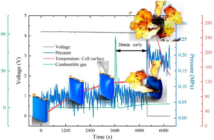A diode is a semiconductor device that allows the flow of electric current in one direction while blocks electric current flow in the other direction. In this post, we will examine how diodes work, their brief history and practical applications. 
Diode – Components, Symbol and Appearance
Image Source: All About Circuits Website
Principle of Operation
The basic construction of a diode consists of N-type and P-type materials, anode, cathode, and the device package that is usually made up of glass and plastic compounds. The N-type material has free electrons that move from a negatively charged area to a positively charged area. The P-type material has holes that appear to be moving (when free electrons are moving) from a positively charged area to a negatively charged area. At no voltage condition, electrons from the N-type material fill the holes from the P-type material along the junction between the layers. At this state, a depletion zone is then formed between the N-type and P-type materials.
Depletion Zone Formed at No Voltage Condition
Moving holes and electrons at Forward-biased condition
Images Source: HowStuffWorks Website
When electric current is applied, with the N-type connected to the negative terminal of the battery and the P-type to the positive terminal, the electrons in the N-type move to the positive electrode while the holes in the P-type move to the negative electrode. The depletion zone disappears and the electric current flows across the diode. At this condition, the diode is forward-biased. A diode made of silicon can be forward-biased by applying 0.7V while a diode made of germanium needs only 0.3V. When the supply polarity is reversed, N-type connected to the positive terminal and P-type to the negative terminal, the diode blocks all the electric current applied to it. In this situation, the depletion zone increases and the diode is reverse-biased.
Brief History
There are two types of diodes that served as the foundation of more sophisticated diodes we are using today. One is the thermionic diode (also known as vacuum tube) and it was invented and patented by John Ambrose Fleming on November 16, 1904. Fleming’s invention is based on Thomas Edison’s principle known as the “Edison effect” during his discovery of the carbon-filaments light bulb.
The second type of diode is the solid-state diode (also known as the semiconductor diode). It was Karl Ferdinand Braun who first discovered and patented the so-called crystal rectifier in 1899. Crystals, because of their rectifying properties, are what makes up the diode. This lead to the development of the germanium diodes in the 1950’s by Bell Laboratories for microwave transmission applications.
Types of Diodes
Image Source: CDS Electronics Website
There are different types of diodes that are used for different applications. Diodes are commonly used in a rectifier circuit, a device that converts alternating current (AC) to direct current (DC). Light-emitting diodes (LED) are widely used in consumer electronics such as the television. Other types of diodes are Zener, photodiodes, Schottky, Gunn, and PIN diodes all of which are used in a wide variety of applications.
Related articles:






